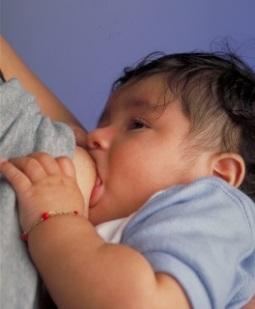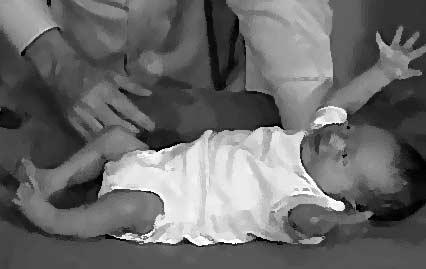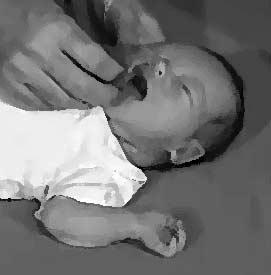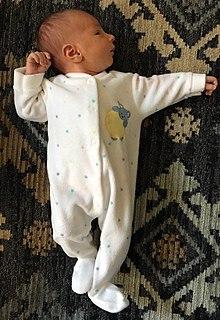4.4 The Newborn
After much anticipation, a new human is born. There is no scientific consensus on what age range constitutes the newborn stage, but it is generally viewed as being the first 3 months of life. According to Harvard Health, this period of development is known as the fourth trimester which starts at birth and continues to the first 12 weeks after birth (Harvard Health, 2021). Newborns will transition from their warm home within the womb to an expansive world full of noises, smells, and people.
Within the first few minutes after birth, newborns will receive their first of many medical procedures. Medical staff will perform an Apgar test to assess a newborn’s heart rate, breathing, muscle tone, reflex response, and color. Within the first 24 hours, newborn babies may receive vaccines or medications, such as vitamin K, an antibiotic eye ointment, or a hepatitis B shot. Most newborns will stay under medical supervision for the first 24 hours to 3 days after birth, but some will remain longer if they are born prematurely, have complications due to delivery, or have special medical needs. Medical staff will monitor breathing patterns, feeding, temperature, urine and bowel movements, and weight. They will also screen for treatable diseases and conduct a hearing test before the child goes home.
Newborn Characteristics
When we picture a newborn in our minds, we may think of a sweet smelling baby with perfect, soft skin. The reality is that after birth, newborns are covered in wet and sticky substances from the womb, including amniotic fluid and blood. Amniotic fluid has a distinct smell and varies from person to person. Babies may also be covered in a white, creamy-like substance known as vernix. Vernix is a natural skin protectant and has antibacterial properties. It is recommended that babies do not get bathed right after birth.
Newborn babies share some common physical characteristics. When they are born, their skin will appear wrinkled and may have a bluish or grayish tint to it from living in amniotic fluid. The skin will start to flake once it dries, which will be noticeable in the hands and feet. Babies may be born with lanugo, which is fine body hair that covers the body. This hair offers warmth and protection in the womb. It falls off on its own shortly after birth. Lanugo helps the vernix stick to the fetus’ skin, which helps insulate the body and protect it from the amniotic fluid. Babies may also have Mongolian spots or bluish-black marks on their backs and buttocks. Sometimes these may be confused for bruises. Newborns may have other types of birthmarks on their bodies as well.
Newborn heads can appear in a variety of shapes after birth. This depends on the type of delivery or the baby’s position in the womb. Some babies may be born with misshapen heads that are cone shaped or flat in some areas. The head shape will usually even out as they develop. A newborn’s skull has several fontanelles, or soft spots, which allow the baby to pass through the birth canal.
Growth charts from the CDC show that the average weight of a baby born at 37–40 weeks ranges from 5 lb., 8 oz. (2.5 kg) to 8 lb., 13 oz. (4 kg) (CDC, 2010). Babies can lose 5 to 10 percent of their body weight after birth, but this can vary depending on whether a baby is fed breast milk or formula (American Pregnancy Association, 2023). After this, babies will experience a period of rapid growth and can double their weight by the time they reach 4 months old.
Sensory Development and Reflexes
Newborns are born with certain sensory capabilities that help them survive in their environment. Immediately after birth, a newborn is sensitive to touch and temperature and is also highly sensitive to pain. They respond to these stimuli with crying and cardiovascular changes (Balaban & Reisenauer, 2013).
Newborns can distinguish between sour, bitter, sweet, and salty flavors and show a preference for sweet flavors. This makes sense considering that breast milk is sweet. Newborns also prefer the smell of their mothers. An infant that is only 6 days old is significantly more likely to turn toward its own mother’s breast than to the breast of another baby’s mother (Porter et al., 1992). Within hours of birth, an infant also shows a preference for the face of its own mother (Bushnell, 2001; Bushnell et al., 1989).
Vision is the most poorly developed sense at birth, and time is needed to build those neural pathways between the eye and the brain. Newborns typically cannot see further than 8 to 16 in. (20.3–40.6 cm) away from their faces. This is about the distance from the newborn’s face to the mother/caregiver when an infant is breastfeeding, chestfeeding, or bottlefeeding.
The newborn’s sense of hearing is very keen at birth, and the ability to hear is evidenced as soon as the 7th month of prenatal development. They are sensitive to their mother’s voices in the womb. A newborn can distinguish between very similar sounds as early as 1 month after birth and can distinguish between a familiar and unfamiliar voice even earlier.
Infants are born with many reflexes, which are involuntary movements in response to stimulation (figures 4.8–4.15). These include a sucking reflex (infants suck on objects that touch their lips automatically), the rooting reflex (this involves turning toward any object that touches the cheek), the palmar grasp (infants tightly grasp any object that is placed in their palm), and the dancing reflex (when the infant is held in a standing position and moves their feet up and down alternately, resembling dancing).
| Reflex | Description | Image |
|---|---|---|
| 1. Sucking | Infants will suck on anything that touches their lips. |  |
| 2. Moro | A sudden noise or loss of support to the head and neck will cause infants to spread out their arms and legs, then quickly contract their limbs inward. |  |
| 3. Rooting | Infants will turn their heads when their cheek is touched. |  |
| 4. Tonic Neck | When lying on the back with the head to one side, infants will extend the arm and leg on that side while flexing the limbs on the opposite side (looks like a fencer’s pose). |  |
| 5. Grasp | The fingers automatically grip anything that touches the palm of the hand. |  |
| 6. Stepping | The legs move in a stepping-like motion when the feet touch a smooth surface. |  |
| 7. Babinski | The infant’s toes will fan out and curl when the sole of the foot is stroked from heel to toe. |  |
Common Newborn Issues
Babies can develop issues in the womb, during labor and delivery, or after birth. One of the most common medical conditions that newborn babies experience is jaundice. Jaundice refers to elevated bilirubin levels that can lead to yellowing of the skin or eyes. When red blood cells break down and are processed by the body, they leave a product called bilirubin. Bilirubin is processed by the liver, and since a newborn’s liver is still immature, this leads to slower metabolism and a buildup of bilirubin. Jaundice usually resolves itself within the first few weeks of life, but some babies may require interventions.
According to the most recent CDC data on childbirth [Website], 1 in 10 babies is born premature in the United States (CDC, 2021). Premature birth, or preterm birth, describes babies that are born before 37 weeks of gestation. There are many reasons why a baby can be born too early, but there are certain factors that can increase the risks, such as maternal health, lack of prenatal care, and environmental toxins. The final weeks of pregnancy are important for the developing fetus because its central nervous system, kidneys, and liver are maturing to prepare for life outside of the womb. Babies are also gaining weight each day, which helps insulate them and keep their bodies warm. The lungs and brain are the last things to develop and continue to form until the fetus reaches full term or 40 weeks of gestation.
People who are pregnant with multiple children may deliver their babies early. This can also occur if pregnancies are not spaced apart and the uterus has not had time to heal. The use of tobacco, drugs, or certain medications can also increase the chances of having a baby preterm. Sometimes, there are other pregnancy complications that require early delivery, such as having low amniotic fluid, placenta issues, or a traumatic event that leads to a severe stress response within the body.
Many babies who are born early will live their lives with little to no complications. Others may experience short-term consequences due to premature birth, such as breathing issues, heart problems, or compromised immune systems. Some babies may develop long-term problems, such as impaired learning, cerebral palsy, or chronic medical conditions, such as asthma. Premature babies are also at increased risk for sudden infant death syndrome or SIDS.
Unfortunately, not all babies will survive after birth. In Chapter 3, we learned that some fetuses develop birth defects or chromosomal abnormalities in the womb. Sometimes this results in a miscarriage or early loss of a baby. The CDC reports that in 2020, there were 20,000 total documented infant deaths in the United States (CDC, 2021). Babies born prematurely or with a low birth weight accounted for 16 percent of all infant deaths, or deaths within the first year of life (CDC, 2021).
The National Vital Statistics Report [Website] shows death trends by race, highlighting the fact that babies of color, especially Black, Latino, and Indigenous babies, die at much higher rates than other groups (Ely & Driscoll, 2021). These disturbing trends highlight societal inequalities, such as racism, and the need to adjust the way we approach health care for all mothers and their children. While many risks can be associated with genetic or biological factors, it is important to consider the quality and accessibility of care that pregnant women receive and the potential long-term effects of mistreatment or misdiagnosis.
Case Study: Amira and Anthony
How does race influence birth experiences and health outcomes?
Amira found out that she was pregnant with her first child when she was 28 years old. While this was a joyous moment for her and her family, she was also scared about what could happen. This fear is typical for many pregnant women, but Amira also experienced fear around race-based issues. She had heard many sad stories about Black women’s experiences in the healthcare system. Birth stories were particularly negative, and sometimes they resulted in serious outcomes for the mothers and children.
Amira was lucky to have high-quality insurance through her job. She was able to choose her doctor and had access to a premium healthcare facility. The first few months of pregnancy passed without any complications, but as she approached 8 months, she experienced recurring stomach pains and shortness of breath. She brought these concerns up to her healthcare team and was told that these were common symptoms of a growing belly. Amira did not feel right, so she called her provider once again and was advised to rest and get off her feet. Amira felt dismissed but also worried that, as a first-time mom, she might be too anxious or stressed, so she decided not to pursue her concerns.
A few days later, Amira experienced debilitating pain throughout her body and started hemorrhaging. Her husband rushed her to the hospital, where Amira lost consciousness due to blood loss. She had an emergency C-section, and her son, Anthony, was born 6 weeks premature. Amira was not able to hold her baby after birth. Anthony spent several months in the hospital before he was able to come home.
Licenses and Attributions for The Newborn
“The Newborn” by Christina Belli is licensed under CC BY 4.0.
“Sensory Development and Reflexes” by Christina Belli is adapted from “Child Growth and Development” by Jennifer Paris, Antoinette Ricardo, & Dawn Rymond, and is licensed under CC BY 4.0. Modifications: simplified language, reduced text, updated images.
Figure 4.6. Newborn Reflexes adapted from Lifespan Development: A Psychological Perspective (page 74) by Martha Lally and Suzanne Valentine-French and is licensed under CC BY-NC-SA 3.0 (modified by Antoinette Ricardo).
Image Row 1: Image is in the public domain.
Image Row 2: Image is in the public domain.
Image Row 3: Image is in the public domain.
Image Row 4: Image by Samuel Finlayson is licensed under CC BY-SA 4.0.
Image Row 5: Image by Raul Luna is licensed under CC BY 2.0.
Image Row 6: Image is in the public domain.
Image Row 7: Image by Medicus of Borg is licensed under CC BY-SA 3.0.

